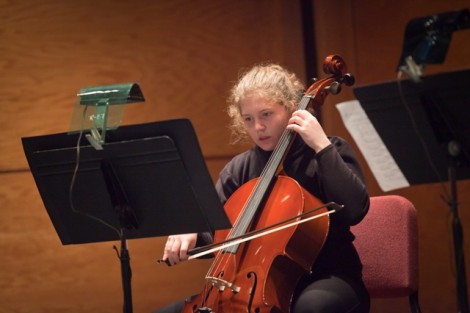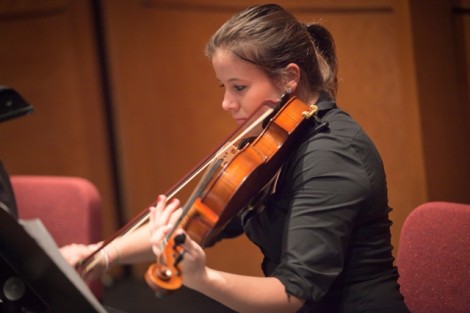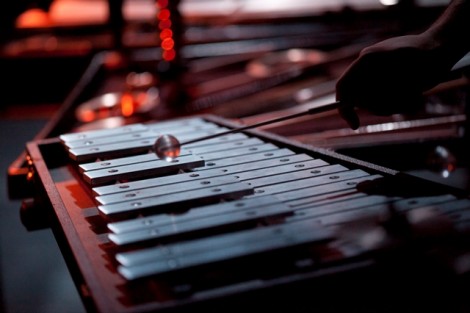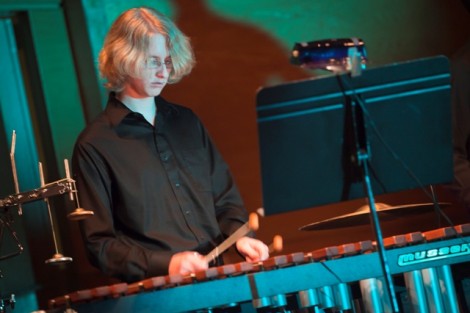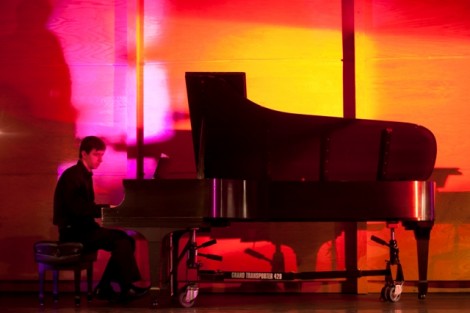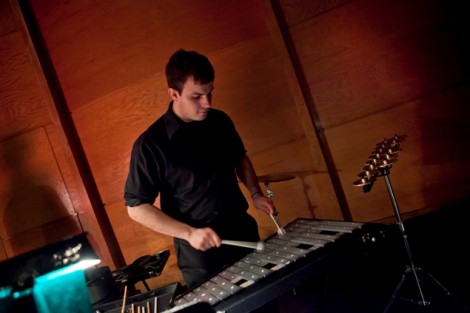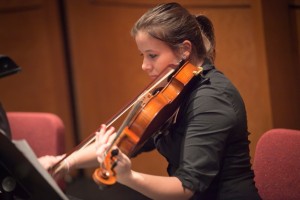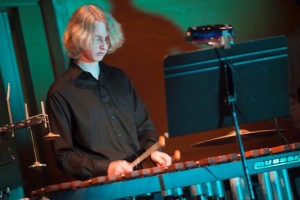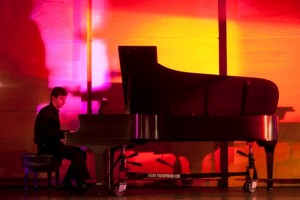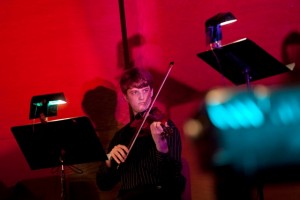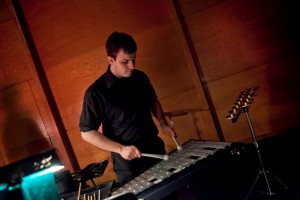When the Contemporary Music Ensemble took the stage for its debut concert this March, it was the product of the innovative vision of its director, Kirk O’Riordan, assistant professor of music and director of bands. The elite chamber group performs music composed in the 20th and 21st centuries by established masters, emerging composers, and students.
At first glance the ensemble may seem to be all about music, but as the diversity of its members indicates, it really is an interdisciplinary endeavor. For instance, to bring to life Karlheinz Stockhausen’s piece From the Seven Days, O’Riordan brought in Carrie Rohman, assistant professor of English. Her literature background helped the student musicians understand the poetic “score” of the piece. A dancer and choreographer, Rohman also performed during the concert.
“Working on this piece with the student musicians and with Professor O’Riordan was, for me, an example of what the liberal arts are really about,” she says. “Bringing together musical and dance elements to perform a textual score and practicing structured improvisation together to create a unique performance — this is what interdisciplinary learning can look like when we work together across our own areas of expertise.”
O’Riordan had clear goals in mind while assembling the invitation-only ensemble. The first is to give his composition students an outlet to hear their pieces performed live and work with live musicians. Computer science major Haruki Yamaguchi ’11(Akashi, Japan) and mathematics and physics double major Gavin Hobbs ’12 (Pen Argyl, Pa.) composed original pieces performed during the ensemble’s first concert.
“Participation in the arts allows students to make connections between art and science: A great composition is engineered, as well as inspired. Great engineering is also inspired,” says O’Riordan. “There is art in solving a problem in a beautiful, creative, original way. It doesn’t matter if the problem deals with making sounds or making buildings — the process is the same. The study of music, and theater, literature, and visual art, allows the student to develop that capacity in an environment for which they already have a passion.”
This was Yamaguchi’s first original composition, a piano quartet entitled Continuous Uncertainty. Yamaguchi says the piece, which elicits feelings of uncertainty and insecurity, can be visualized by imagining that the music is “represented by a number of dimly lit pendulums in a dark room, which keep vibrating and swinging back and forth while emitting bursts of bright light now and then.” Music is an integral part of his computer science honors project on a crossover area of computer science/mathematics and music known as algorithmic composition.
“Every time I go to an advanced music class, I’m reminded of how lucky I am to be able to pursue two very different fields at the same time,” says Yamaguchi, who has been playing piano since age 4 and has been mostly self-taught since age 11. “Music provides a good break from doing problem sets, solving equations, and writing code, and my technical major has led me to explore other areas of music such as digital music using virtual synthesizers.”
As a child learning the piano, Hobbs always enjoyed improvising over practicing. He first started composing when his father told him either to practice or write down his improvisations. The ensemble performed his original piece, Theme and Variation, an exploration of the different compositional and musical styles Hobbs has studied. He sees many parallels between music and his academic studies.
“My mathematical outlook leads me to appreciate order, complexity, and intricacy, and these are some of the aspects I enjoy in music,” says Hobbs, who also has sung tenor in choirs and played in a hand-bell choir. “Music is very mathematical in its rhythm and timings. Both contain recurring and changing patterns, which lead me to see beauty in both math and music. Some people may say, and I agree, that music is one way to artistically express the beauty of mathematics, but I think the converse can also be true – math or physics can be a beautiful way to express the patterns of music.”
In addition to giving student composers a platform, O’Riordan also wanted a space for some exceptionally talented student musicians to dive into more complex material. Michael Pinkard ’14 (Puyallup, Wash.), who plays clarinet and saxophone, had the opportunity to perform with a high-level group his first year on campus.
Pinkard describes music as “a way of life,” and intends to declare majors in physics and music. The campus music scene is something that brings together students from a variety of backgrounds and disciplines, he says.
“The music department is really happening on this campus,” he says. “Kirk O’Riordan makes it possible for students of all majors to come together and create unique, refined, meaningful works of art. Students share a love of music and drive to play and learn, which is why this ensemble is possible.”
O’Riordan also wanted the ensemble to draw students with outstanding musical ability who are looking for a strong liberal arts education. Megan Myron ’14 (Scarsdale, N.Y.), who plays viola, is a perfect example of that. She attended Juilliard School’s pre-college program but did not want to attend a conservatory or Juilliard for college. She can’t imagine her life without music and intends to double major in music and mathematics-economics. The invitation to perform with the ensemble is one of the greatest opportunities she’s had so far at Lafayette.
“There are no biases or rules in music,” says Myron. “Musicians are completely free to do whatever they want, be artistic, and make a piece of their own. Being able to play with students at a high level is very rewarding.”
Other ensemble members are Maureen Carey ’14 (Syracuse, N.Y.), flute; music major Zach Jones ’13 (Bethlehem, Pa.), piano; mathematics-economics major Chris Jose ’11 (Stroudsburg, Pa), violin; and Rachel Loven ’14 (Emmaus, Pa.), violoncello. Guest musicians for the ensemble’s first concert were Anna Maria Marzullo, visiting instructor of music; government and law major Alex Cutrone ’13 (Yorktown Heights, N.Y.), percussion; math major Michael Follett ’11 (Lebanon, Pa.), flute; and electrical and computer engineering majors Tony Lorence ’13 (Cumbola, Pa.) and Benjamin Richards ’14 (Derry, Pa.), both percussion.
